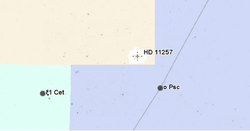54 Ceti
| Observation data Epoch J2000 Equinox J2000 | |
|---|---|
| Constellation | Aries |
| Right ascension | 01h 50m 51.97276s[1] |
| Declination | +11° 02′ 36.1563″[1] |
| Apparent magnitude (V) | 5.94[2] |
| Characteristics | |
| Spectral type | F2 Vw[3] |
| U−B color index | –0.03[2] |
| B−V color index | +0.30[2] |
| R−I color index | 0.17 |
| Astrometry | |
| Radial velocity (Rv) | +11.1[4] km/s |
| Proper motion (μ) | RA: –69.39[1] mas/yr Dec.: –28.45[1] mas/yr |
| Parallax (π) | 23.80 ± 0.44[1] mas |
| Distance | 137 ± 3 ly (42.0 ± 0.8 pc) |
| Details | |
| Radius | 1.2–1.8[5] R☉ |
| Surface gravity (log g) | 4.50[3] cgs |
| Temperature | 7,099[3] K |
| Metallicity [Fe/H] | –0.20[3] dex |
| Rotational velocity (v sin i) | 29[6] km/s |
| Other designations | |
| Database references | |
| SIMBAD | data |
54 Ceti is an older Flamsteed designation[8] for a star that is now located within the constellation boundaries of Aries,[9] the Ram. In the present day it is known by star catalogue identifiers like HD 11257 or HR 534.[7] At an apparent visual magnitude of 5.94,[2] it can be seen with the naked eye. The distance to this star, as determined using parallax measurements made during the Hipparcos mission, is approximately 139 light-years (43 parsecs), give or take a 6 light-year margin of error.[1] It is located near the ecliptic and hence is subject to occasional occultations by the Moon and planets.[7]
This is an F-type main sequence star with a stellar classification of F2 Vw,[3] where the 'w' indicates weak absorption lines in the spectrum. It is a candidate member of the Ursa Major Moving Group, which has an estimated age of 500 ± 100 million years.[10]
References
- 1 2 3 4 5 6 van Leeuwen, F. (November 2007), "Validation of the new Hipparcos reduction", Astronomy and Astrophysics, 474 (2): 653–664, arXiv:0708.1752, Bibcode:2007A&A...474..653V, doi:10.1051/0004-6361:20078357.
- 1 2 3 4 Johnson, H. L.; et al. (1966). "UBVRIJKL photometry of the bright stars". Communications of the Lunar and Planetary Laboratory. 4 (99). Bibcode:1966CoLPL...4...99J.
- 1 2 3 4 5 Cenarro, A. J.; et al. (January 2007), "Medium-resolution Isaac Newton Telescope library of empirical spectra - II. The stellar atmospheric parameters", Monthly Notices of the Royal Astronomical Society, 374 (2): 664–690, arXiv:astro-ph/0611618, Bibcode:2007MNRAS.374..664C, doi:10.1111/j.1365-2966.2006.11196.x.
- ↑ Wilson, Ralph Elmer (1953), General Catalogue of Stellar Radial Velocities, Washington: Carnegie Institution of Washington, Bibcode:1953GCRV..C......0W.
- ↑ Pasinetti Fracassini, L. E.; et al. (February 2001), "Catalogue of Apparent Diameters and Absolute Radii of Stars (CADARS) - Third edition - Comments and statistics", Astronomy and Astrophysics, 367: 521–524, arXiv:astro-ph/0012289, Bibcode:2001A&A...367..521P, doi:10.1051/0004-6361:20000451.
- ↑ Royer, F.; Zorec, J.; Gómez, A. E. (February 2007), "Rotational velocities of A-type stars. III. Velocity distributions", Astronomy and Astrophysics, 463 (2): 671–682, arXiv:astro-ph/0610785, Bibcode:2007A&A...463..671R, doi:10.1051/0004-6361:20065224.
- 1 2 3 "54 Cet". SIMBAD. Centre de données astronomiques de Strasbourg. Retrieved 2012-08-18.
- ↑ Hoffleit, Dorrit (1964), Catalogue of bright stars (3rd revised ed.), New Haven, Conn.: Yale University Observatory, Bibcode:1964cbs..book.....H. See the Online Data entry for HR 534.
- ↑ Hoffleit, D. (July 1979), "Discordances in star designations", Bulletin d'Information du Centre de Donnees Stellaires (17): 38, Bibcode:1979BICDS..17...38H.
- ↑ Monier, R. (November 2005), "Abundances of a sample of A and F-type dwarf members of the Ursa Major Group", Astronomy and Astrophysics, 442 (2): 563–566, Bibcode:2005A&A...442..563M, doi:10.1051/0004-6361:20053222.
